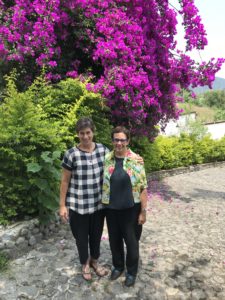In a world that seems to grow meaner by the minute, I was delighted to find a bright spot last week in the mountains of Tepotzlan, Mexico. There, for two weeks, the Association Montessori Internationale (AMI) held their global convening. Teachers, principals, and other educators gathered to study, to learn and to share experiences from every corner of the world. I was invited to give one of the daily keynotes: Arts and Creativity: Key to Learning. As an international organization, AMI is taking a closer look at the ways in which arts learning can be better integrated into the curriculum. Adele Diamond, UBC Professor of Developmental Cognitive Neuroscience, spoke about movement and brain development with a particular focus on executive function and how a Montessori education might further promote positive learning. Other speakers included educators from Kenya talking about their work in refugee camps, Mexican educators sharing their work in Montessori high schools with adolescents as change agents, as well as educators working in indigenous communities. Lynne Lawrence, the ED of AMI, continued to draw connections between education and human rights and the imperative of a Montessori education being rooted in the process of positive social change.
Maria Montessori’s writings provided the common thread for the convening and it was exhilarating to see how her writing on the whole child  continues to deepen educators’ understanding of what’s important in teaching and learning whether one is in Pakistan, the Netherlands, Poland or Mexico. I was reminded of my work with Pat Carini and Vito Perrone on the “descriptive review of the child.” Montessori doesn’t use this phrase but the idea of the three pillars of Montessori education: scientific exploration, theory and practical implications certainly reflect the philosophies of Carini and Perrone. For Dr. Montessori, science always preceded theory. Theory emerged from observation and discovery—and then that became the way she described human development. Montessori’s exhortations for a radically transformed education and for careful attention to our “forgotten citizens”—children—remain as relevant today as in the early 20th century (Montessori, 1947).
continues to deepen educators’ understanding of what’s important in teaching and learning whether one is in Pakistan, the Netherlands, Poland or Mexico. I was reminded of my work with Pat Carini and Vito Perrone on the “descriptive review of the child.” Montessori doesn’t use this phrase but the idea of the three pillars of Montessori education: scientific exploration, theory and practical implications certainly reflect the philosophies of Carini and Perrone. For Dr. Montessori, science always preceded theory. Theory emerged from observation and discovery—and then that became the way she described human development. Montessori’s exhortations for a radically transformed education and for careful attention to our “forgotten citizens”—children—remain as relevant today as in the early 20th century (Montessori, 1947).
I was struck by how these educators viewed their work as both education and human rights. I was also delighted by how the teachers understood that “mysterious powers exist within the child, and that these reveal themselves spontaneously through the child’s activities…” (Montessori, 1912). The teacher, therefore, must be worthy of the child, and not the other way around. “Children want to know everything and ask an infinite variety of questions and their unfortunate teachers, as a rule, know so little.” But this was not the case in Tepotzlan. These teachers knew a LOT and were coming together to share ideas about the role of the arts in learning, the use of a variety of materials, teaching or reading or how to better fundraise… This gathering of educators embraced the “idea of school as an institution for the cultivation of humanity” (Montessori, 100). And it was probably not a coincidence that my comments on the negative role of high stakes testing resonated with this group. These teachers come together to do just as Montessori urged, “seeking advice and guidance from university professors, broadening their psychic life, researching fields otherwise unexplored” (Montessori, 100).
I was truly proud and humbled to be part of this gathering for deep study and learning.
Sources:
Montessori, Maria. “The Forgotten Citizen.” 1947.
Montessori, Maria. The Montessori Method. Frederick A. Stokes Company, 1912, digital.library.upenn.edu/women/montessori/method/method.html.
Montessori, Maria. The Montessori Series, Volume 14, Citizen of the World: Key Montessori Readings. Montessori-Pierson Publishing Company, Amsterdam, the Netherlands, 2019


